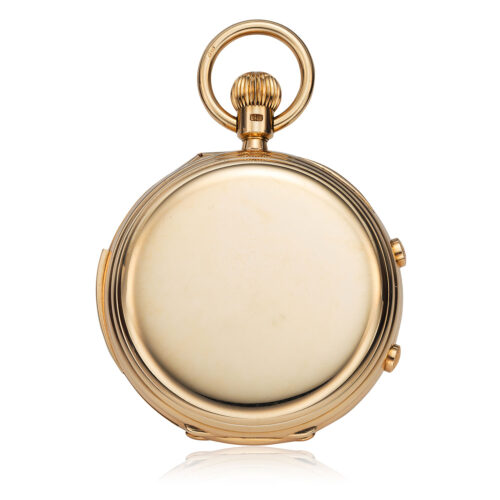S. SMITH AND SON MINUTE REPEATING SPLIT SECONDS PERPETUAL CALENDAR POCKET WATCH
Imagine holding in your hand a marvel of mechanical artistry — a watch that not only tells time but also encapsulates the pinnacle of horological innovation from a bygone era. Grand Complication timepieces stand as monumental achievements in watchmaking, offering a glimpse into the rich history of horology through some of its most captivating creations. Crafted by best-of-the-best watchmakers, these mechanical masterpieces unite multiple complications — such as a minute repeater, a perpetual calendar, and a split-seconds chronograph — into one complex mechanism. Each function operates both independently and synergistically, highlighting the exceptional skill and craftsmanship of its maker. The rarity and unparalleled expertise required to create such watches elevate them to the status of highly coveted treasures in the horological world. And perhaps most surprisingly, especially for our website offerings, this celebrated mechanical art is not a Patek Philippe, it is a British made S. Smith & Son.
Founded in 1851, S. Smith & Son emerged as a leading force in British horology, significantly contributing to the era’s technological advancements in timekeeping. The company was renowned for supplying precision instruments to the British military and naval forces and was appointed official watchmakers to royalty, underscoring their esteemed reputation. This particular Grande Complication watch not only exemplifies the pinnacle of their craftsmanship but also mirrors the innovative spirit of the time. The collaboration with the illustrious movement maker Nicole Nielsen — celebrated for pioneering watchmaking innovations — amplifies the piece’s historical importance. Furthermore, its success at the Kew Observatory trials — an institution revered for its stringent accuracy tests — highlights the watch’s superior precision and engineering excellence. This timepiece stands as a tangible representation of the rich legacy and ingenuity that defined British watchmaking at the turn of the 20th century. Patek Philippe was very much aware of their English competition and watches such as this timepiece inspired and challenged Patek Philippe to push the limits of their watchmaking, in particular in the production of complicated timepieces.
In the late 19th and early 20th centuries, British watchmakers were producing some of the world’s finest timepieces, now prized by collectors for their scarcity, complexity, and aesthetic beauty. This S. Smith & Son Grande Complication pocket watch is the ultimate example from this golden age of British horology. Combining a minute repeater, split-seconds chronograph, and a perpetual calendar with a moon phase indicator, this timepiece is a true masterpiece from the turn of the 20th century.
Only four of these extraordinary watches are believed to have been made. Two, numbered 148-2 and 148-3, are housed in the Clockmakers Company Museum in London, while number 148-1 was featured in period advertisements.
The watch’s craftsmanship is nothing short of exceptional. It features a substantial 59mm hunter case crafted from solid 18-karat gold, weighing in at a hefty 239.1 grams (approximately 0.5 pounds). The massive case comprises four components and showcases the finest English standards, including 5-knuckle hinges for the inner cuvette and the front and back covers. Hallmarked with “SS” for Smith and Sons and London marks from 1899, the case includes a slide mechanism at 6 o’clock to activate the minute repeater, which chimes the hours, quarters, and minutes on two gongs. The split-seconds chronograph is operated by pushers at 11 and 1 o’clock, with elapsed time displayed on a 60-minute recorder within the 12 o’clock sub-dial that also indicates the leap year and months.
The white enamel dial, adorned with Roman numerals, elegantly presents multiple subsidiary dials for the day of the week, date, and constant seconds, along with an aperture for the moon phase. Made and signed by Frederick Willis — whose dials were considered the highest quality and used by Britain’s best watchmakers — the dial itself is a work of art.
Research indicates that the movement was supplied by Nicole Nielsen, a firm renowned for their innovative contributions to watchmaking, including the development of keyless winding mechanisms. This watch was submitted to the Kew Observatory for testing in 1899, where it achieved an “A” certificate with 70.4 marks in the “Complicated Category,” underscoring its exceptional quality. The watch remains in original condition, and its minute repeater produces a magnificent tone that is both loud and resonant.
This S. Smith & Son pocket watch embodies the spirit of ingenuity and innovation that has defined British horology throughout history. For the discerning collector, this Grande Complication represents the zenith of British watchmaking—a true connoisseur’s dream and a timeless testament to an outstanding legacy.
Sold















